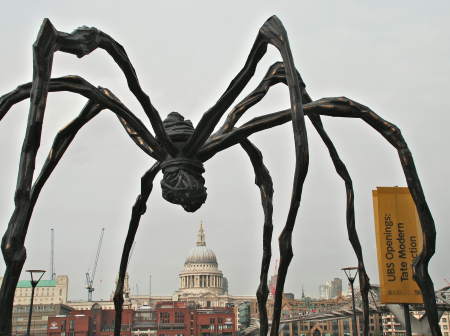
From Holland Cotter in the New York Times:
Louise Bourgeois, the French-born American artist who gained fame only late in a long career, when her psychologically charged abstract sculptures, drawings and prints had a galvanizing effect on younger artists, particularly women, died on Monday at the Beth Israel Medical Center in Manhattan. She was 98.
The death was reported by Wendy Williams, the managing director of the Louise Bourgeois Studio.
Ms. Bourgeois’s sculptures in wood, steel, stone and cast rubber, often organic in form and sexually explicit, emotionally aggressive yet witty, covered many stylistic bases. But from first to last they shared a set of repeated themes, centered on the human body and its need for nurture and protection in a frightening world.
Among her most familiar sculptures was the much-exhibited “Nature Study” (1984), a headless sphinx with powerful claws and multiple breasts. Perhaps the most provocative was “Fillette” (1968), a large, detached latex phallus. Ms. Bourgeois can be seen carrying this object, nonchalantly tucked under one arm, in a portrait by the photographer Robert Mapplethorpe taken for the catalog of her 1982 retrospective at the Museum of Modern Art. (In the catalog, the Mapplethorpe picture is cropped to show only the artist’s smiling face.)

from the full obituary:
“The subject of pain is the business I am in,” she said. “To give meaning and shape to frustration and suffering.” She added: “The existence of pain cannot be denied. I propose no remedies or excuses.” Yet it was her gift for universalizing her interior life as a complex spectrum of sensations that made her art so affecting...
Certainly her personal style contributed to her mystique. Petite in size, gruff of voice and manner, outspoken but suspicious of interviewers, she spent much of her time either in her home in Chelsea or in her studio in Brooklyn...
A lifelong insomniac, she often stayed up drawing or writing in her journal, in the same plain, epigrammatic style in which she spoke...
“I have a religious temperament,” Ms. Bourgeois, a professed atheist, said about the emotional and spiritual energy that she poured into her work. “I have not been educated to use it. I’m afraid of power. It makes me nervous. In real life, I identify with the victim. That’s why I went into art.”
